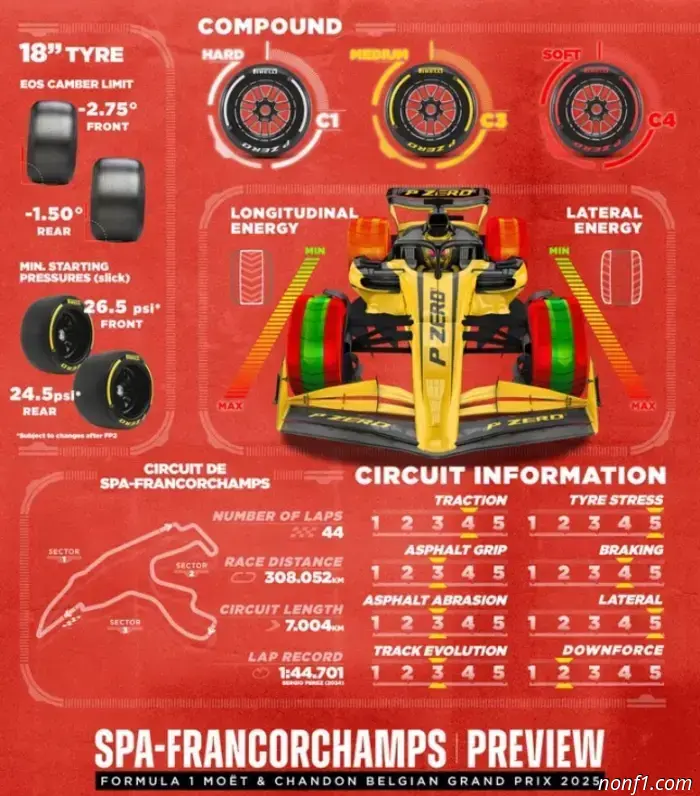
Choosing rubber compositions for the Spa is not the most usual.
The second half of the 2025 season begins with a round on the classic Spa circuit, where the Belgian Grand Prix will take place from July 25 to 27.
This will be the third race weekend of the season, featuring a sprint race, so there will be only one practice session on Friday, followed by qualifying for the sprint. On Saturday, a short 15-lap race will be held, and only then will the main qualifying session take place to determine the starting order for the Sunday Grand Prix.
Pirelli approached the tire selection for the Belgian round in an unconventional way: the compounds are not chosen sequentially. C1, the hardest in the entire range, is used as the Hard compound, while C3 serves as the Medium, and C4 is offered as Soft. The previous similar approach was used at the 2022 Australian Grand Prix, where the tire triad included C2 (Hard), C3 (Medium), and C5 (Soft).
C3 and C4 were also used in Belgium in 2024, so the only element of novelty is the choice of C1 as the hardest compound. Computer modeling technologies enable Pirelli to hypothesize that such a selection should increase the level of intrigue, as the uncertainty in tire performance is expected to grow.
Additionally, when the race weekend program includes a sprint, drivers receive one set fewer tires. Each driver will have 12 dry weather tire sets: six Softs, and two each of Medium and Hard. During the first two parts of Friday’s qualifying for the sprint, only medium tires are allowed, with Softs permitted in the final session.
However, the Ardennes region is also known for its variable weather, and it is not uncommon for one part of the track to be flooded while the other is bathed in summer sun. Accordingly, there is a high likelihood that wet weather tires—both Intermediate and Extreme Wet—will be used, i.e., intermediate tires and full rain tires.
Last year, a two-stop strategy was preferred, and the most effective and degradation-resistant option was the hardest compound tire. Out of twenty drivers, nineteen finished the race, and only five completed with a single pit stop—George Russell, Fernando Alonso, Lance Stroll, Kevin Magnussen, and Yuki Tsunoda.
They all started on Medium and then switched to Hard. However, only Russell, who was the first to see the checkered flag, and Alonso, who finished ninth, made it into the top ten. Post-race technical inspection revealed that Russell’s car was lighter than the allowed minimum, and the Mercedes driver was disqualified, so the victory went to his teammate, Lewis Hamilton. The seven-time world champion chose to complete the race with two pit stops, starting on Medium and then using two sets of Hard tires.
It is also worth recalling that before last year’s Belgian Grand Prix, a significant portion of the asphalt surface was renewed—the goal was to achieve higher grip and smooth out the most noticeable irregularities. Subsequently, the asphalt became much less abrasive, grip increased significantly, leading to a noticeable boost in pace.


Other articles
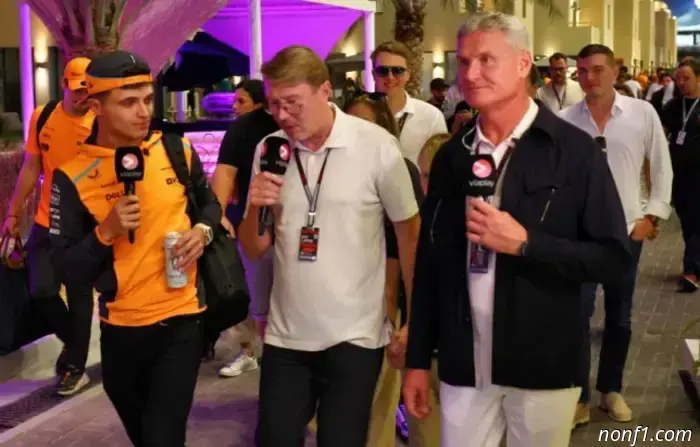 Kulthard: For an ideal scenario, Ferrari should be added.
David Coulthard, a former racing driver who competed for McLaren, is following the rivalry between Oscar Piastri and Lando Norris with interest, and he really likes how the season is unfolding...
Kulthard: For an ideal scenario, Ferrari should be added.
David Coulthard, a former racing driver who competed for McLaren, is following the rivalry between Oscar Piastri and Lando Norris with interest, and he really likes how the season is unfolding...
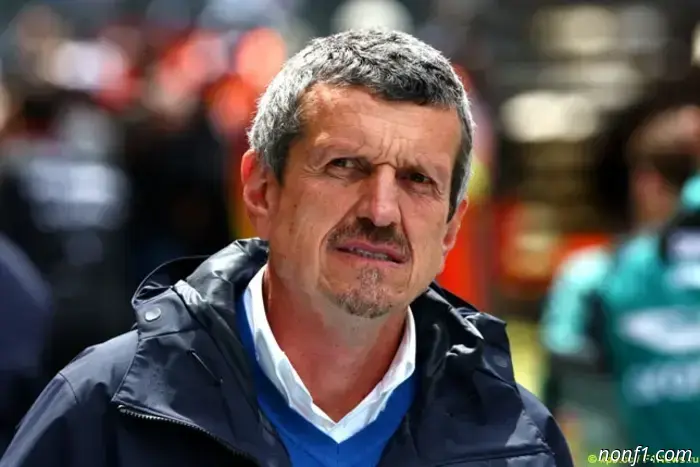 Shtainer: Cadillac won't take an American driver.
The racing world continues to discuss the candidates for two spots in the new Cadillac team. Günther Steiner named his four favorites and suggested that there will definitely be no American driver in Cadillac's debut season.
Shtainer: Cadillac won't take an American driver.
The racing world continues to discuss the candidates for two spots in the new Cadillac team. Günther Steiner named his four favorites and suggested that there will definitely be no American driver in Cadillac's debut season.
 IndyCar: Zak Brown congratulated O'Ward on his victory in Toronto
Don't be surprised if rumors about Pato O'Ward and Cadillac increase: he won the race in Toronto, and he can once again be considered a contender for the title...
IndyCar: Zak Brown congratulated O'Ward on his victory in Toronto
Don't be surprised if rumors about Pato O'Ward and Cadillac increase: he won the race in Toronto, and he can once again be considered a contender for the title...
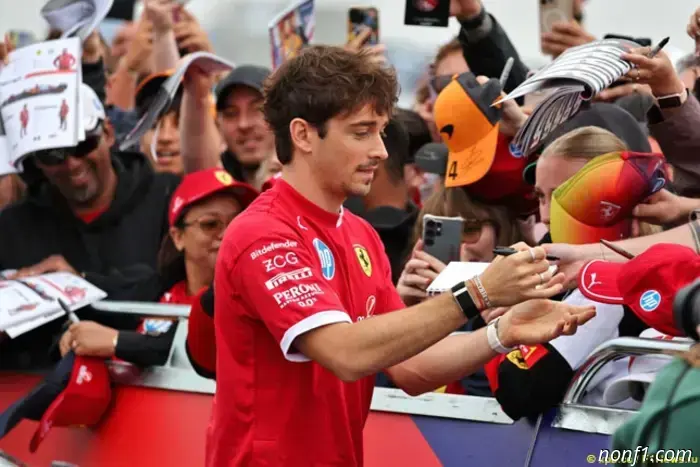 Belgian Grand Prix: Forecast Competition Stage
The acceptance of predictions for the Belgian Grand Prix results in our Contest is ongoing.
Belgian Grand Prix: Forecast Competition Stage
The acceptance of predictions for the Belgian Grand Prix results in our Contest is ongoing.
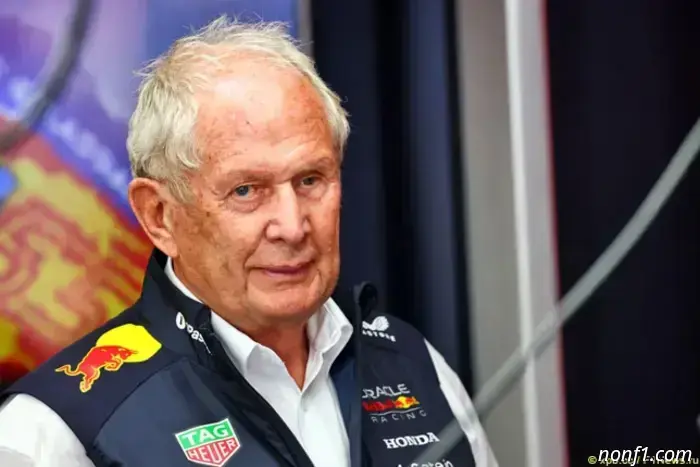 Marco advised Red Bull employees to smile more.
Interesting details about the atmosphere at the Red Bull Racing base in Milton Keynes were uncovered by the British tabloid The Sun.
Marco advised Red Bull employees to smile more.
Interesting details about the atmosphere at the Red Bull Racing base in Milton Keynes were uncovered by the British tabloid The Sun.
 Piastre: A Spa Stage – one of the most vibrant moments of the season
This weekend at Spa, Oscar Piastri and Lando Norris will continue their battle for the lead in the standings. The McLaren drivers said they really enjoy the Belgian track, and they are both looking forward to the upcoming race.
Piastre: A Spa Stage – one of the most vibrant moments of the season
This weekend at Spa, Oscar Piastri and Lando Norris will continue their battle for the lead in the standings. The McLaren drivers said they really enjoy the Belgian track, and they are both looking forward to the upcoming race.
Choosing rubber compositions for the Spa is not the most usual.
Choosing tires for the Belgian stage is not the most conventional: the compositions are not selected in a consistent manner...
